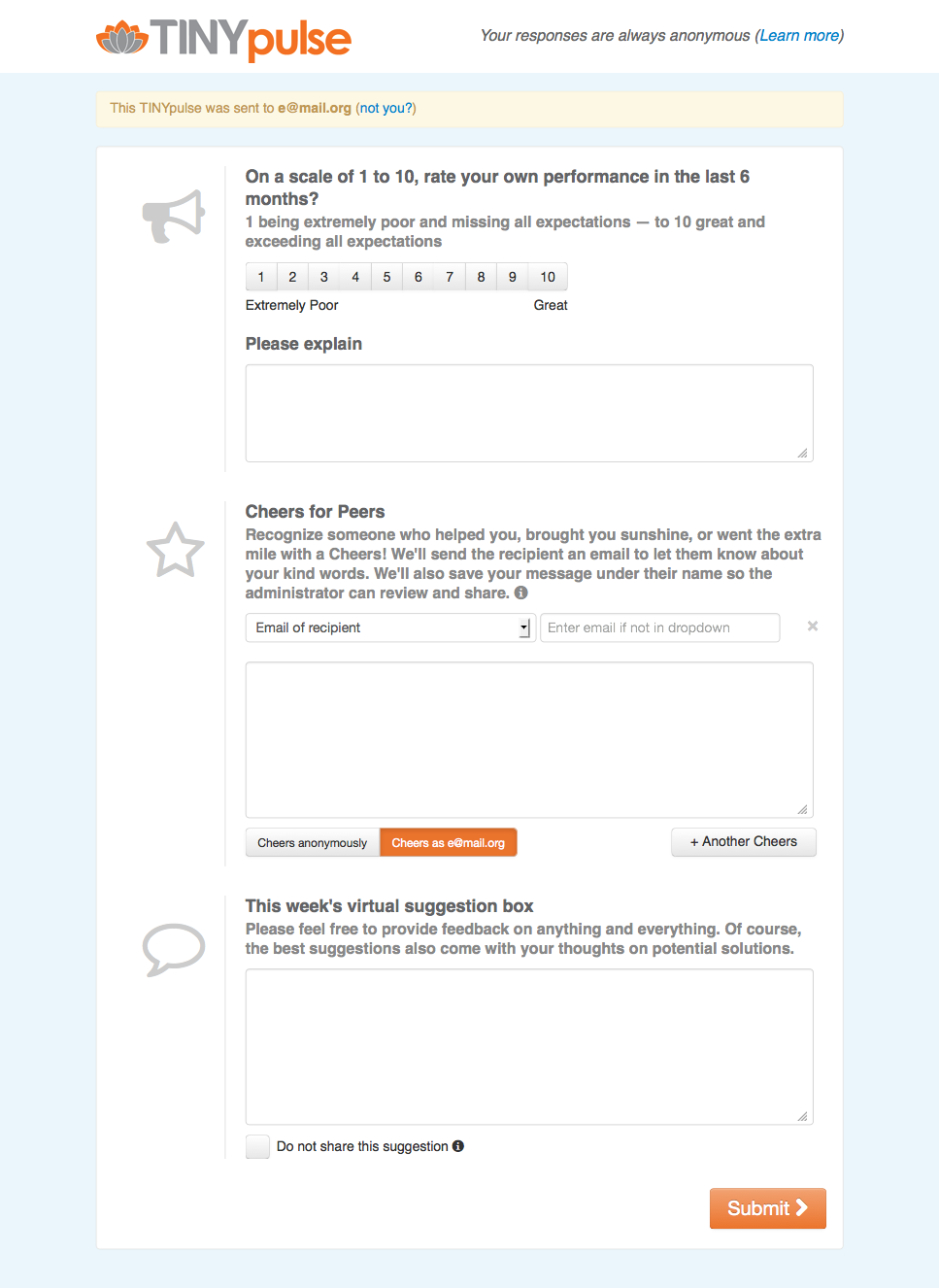
How to Get Useful Feedback From Your Employees
Feedback is an important part of understanding the driving forces behind a business. Are employees happy and engaged? Are customers satisfied? Are managers being effective?
Most employee-operated businesses have some form of feedback mechanism in place to ascertain how people feel about their work environment, their coworkers, and their leaders. The most common option is the occasional employee review or satisfaction survey.
But is this feedback sufficient to create real change?
After all, receiving feedback is about pinpointing areas of weakness so that adjustments can be made. The answer to that question isn’t quite as black and white as you’d think.
[content_upgrade cu_id=”435″]Download These 7 Tools That Track Employee Feedback[content_upgrade_button]Click Here[/content_upgrade_button][/content_upgrade]


 Other forms of real-time engagement surveys can act as a corporate “mood ring” to give organizations up-to-date feedback in order to create actionable results. But where and when these surveys are implemented is also important for success.
Running surveys for both new hires and during exit interviews can help leaders and managers assess the quality of an employee’s lifespan. How long are people staying with the company? What gets people excited when they start working versus when they’ve been there a while? What is the primary reason for employee turnover?
These questions can help improve processes and create better workplace dynamics for employees. It’s also important for companies to remove any repercussions for answering questions, even if the surveys are anonymous.
Truly effective surveys will also ask the right kinds of questions. Questions like the following can all be helpful:
Other forms of real-time engagement surveys can act as a corporate “mood ring” to give organizations up-to-date feedback in order to create actionable results. But where and when these surveys are implemented is also important for success.
Running surveys for both new hires and during exit interviews can help leaders and managers assess the quality of an employee’s lifespan. How long are people staying with the company? What gets people excited when they start working versus when they’ve been there a while? What is the primary reason for employee turnover?
These questions can help improve processes and create better workplace dynamics for employees. It’s also important for companies to remove any repercussions for answering questions, even if the surveys are anonymous.
Truly effective surveys will also ask the right kinds of questions. Questions like the following can all be helpful:

Benefits of Employee Feedback
On one hand, feedback can give companies insight into the behind-the-scenes attitudes and behaviors of employees. Companies that create positive feedback cultures – where employees have the ability to provide feedback freely – tend to have staff that is more invested, engaged, and productive overall. They are also more likely to predict (or even prevent) employee turnover. Regular pokie payid feedback can alert managers to major and minor issues that may cause employees to leave the company prematurely. This can help solve costly HR issues as well as foster a sense of community and pride in the company. But that doesn’t mean feedback is automatically a magical tool. The type of feedback being gathered matters, as well as how it’s used. Managers that focus on collecting feedback about employee strengths, for instance, are more likely to managed actively engaged employees compared with managers that focus on weaknesses. So while feedback can help identify areas of struggle, they shouldn’t necessarily be targeted towards finding problems. The most frequent tools used for collecting feedback (surveys or questionnaires) also come with their own set of hindrances.Why Surveys Aren’t Enough
While surveys may seem like the easiest way to get inside the mind of employees, research shows that they’re not as effective as we think. In fact, 48% of HR professionals say they don’t believe employee surveys provide honest and accurate assessments, and 58% say that survey results don’t actually help managers gain a greater knowledge of behaviors and practices they can change to improve. One Cornell National Social Survey reveals that employees often withhold information about problems in the workplace because of a sense of futility: they don’t believe the problems will be solved. The survey also found that employees were often hesitant to present unique ideas for the same reason. They simply didn’t believe that their ideas would be implemented. Futility, according to the study, was almost the primary reason for withholding information on a feedback survey. Another issue is that surveys are often not comprehensive enough to get a clear picture. Most surveys are done on single employees or small teams instead of company wide, and the small sample size may ultimately skew results. Surveys also tend to be too long, so they are often left unfinished behind piles of more important work. If the questions are irrelevant to the actual needs of the employees or there is little to no follow-through after a survey has been completed, it could increase a sense of futility. So if feedback surveys aren’t the answer, what is? It turns out that some surveys can work, but only if they take into account the problems listed above.
How to Get Helpful Feedback
One of the ways companies can create productive and effective surveys is by changing the style of the survey itself. Unlike traditional employee feedback surveys, pulse surveys – small, simple and frequent quizzes that target specific types of feedback – can help companies assess the overall “pulse” of a company on a daily basis (hence the name). These types of surveys gauge the culture of a company rather than specific pain points. TINYPulse, for example, allows companies to send out one question a week to employees. Answers are anonymous and managers can analyze and generate reports from the findings whenever needed. Additionally, employees have the opportunity to send suggestions for improvements back to management whenever they want. Other forms of real-time engagement surveys can act as a corporate “mood ring” to give organizations up-to-date feedback in order to create actionable results. But where and when these surveys are implemented is also important for success.
Running surveys for both new hires and during exit interviews can help leaders and managers assess the quality of an employee’s lifespan. How long are people staying with the company? What gets people excited when they start working versus when they’ve been there a while? What is the primary reason for employee turnover?
These questions can help improve processes and create better workplace dynamics for employees. It’s also important for companies to remove any repercussions for answering questions, even if the surveys are anonymous.
Truly effective surveys will also ask the right kinds of questions. Questions like the following can all be helpful:
Other forms of real-time engagement surveys can act as a corporate “mood ring” to give organizations up-to-date feedback in order to create actionable results. But where and when these surveys are implemented is also important for success.
Running surveys for both new hires and during exit interviews can help leaders and managers assess the quality of an employee’s lifespan. How long are people staying with the company? What gets people excited when they start working versus when they’ve been there a while? What is the primary reason for employee turnover?
These questions can help improve processes and create better workplace dynamics for employees. It’s also important for companies to remove any repercussions for answering questions, even if the surveys are anonymous.
Truly effective surveys will also ask the right kinds of questions. Questions like the following can all be helpful:
- Are employees happy? Happiness is often linked to engagement and productivity. What areas of the workflow process are employees the most (or least) happy with?
- What don’t employees like? There are inevitable aspects of every job that employees dread. What are they and how can they be minimized?
- Do employees feel valued? Employees that don’t feel appreciated are less engaged and productive. Is leadership showing enough appreciation for employees and if not, why?
- Do employees like their colleagues? Coworkers are often listed as both the number one reason people love their jobs as well as the number one annoyance. If employees don’t get along with their coworkers, why? What can be done to foster a sense of community?

